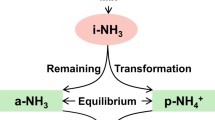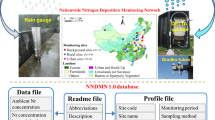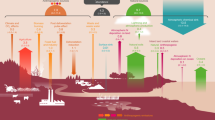Abstract
Through its important role in the formation of particulate matter, atmospheric ammonia affects air quality and has implications for human health and life expectancy1,2. Excess ammonia in the environment also contributes to the acidification and eutrophication of ecosystems3,4,5 and to climate change6. Anthropogenic emissions dominate natural ones and mostly originate from agricultural, domestic and industrial activities7. However, the total ammonia budget and the attribution of emissions to specific sources remain highly uncertain across different spatial scales7,8,9. Here we identify, categorize and quantify the world’s ammonia emission hotspots using a high-resolution map of atmospheric ammonia obtained from almost a decade of daily IASI satellite observations. We report 248 hotspots with diameters smaller than 50 kilometres, which we associate with either a single point source or a cluster of agricultural and industrial point sources—with the exception of one hotspot, which can be traced back to a natural source. The state-of-the-art EDGAR emission inventory10 mostly agrees with satellite-derived emission fluxes within a factor of three for larger regions. However, it does not adequately represent the majority of point sources that we identified and underestimates the emissions of two-thirds of them by at least one order of magnitude. Industrial emitters in particular are often found to be displaced or missing. Our results suggest that it is necessary to completely revisit the emission inventories of anthropogenic ammonia sources and to account for the rapid evolution of such sources over time. This will lead to better health and environmental impact assessments of atmospheric ammonia and the implementation of suitable nitrogen management strategies.
This is a preview of subscription content, access via your institution
Access options
Access Nature and 54 other Nature Portfolio journals
Get Nature+, our best-value online-access subscription
$29.99 / 30 days
cancel any time
Subscribe to this journal
Receive 51 print issues and online access
$199.00 per year
only $3.90 per issue
Buy this article
- Purchase on Springer Link
- Instant access to full article PDF
Prices may be subject to local taxes which are calculated during checkout




Similar content being viewed by others
Data availability
The NH3 map is available in NetCDF and KMZ formats. The latter file includes the identified hotspots and source regions and is provided in the Supplementary Information. The supplement also includes the 28 hotspot illustrations. The NetCDF file of the NH3 map and the reanalysed IASI NH3 dataset (ANNI-NH3-v2.1R-I) described in Methods are available from the PANGAEA repository (https://doi.org/10.1594/PANGAEA.894736); more recent versions of IASI NH3 datasets are available from the AERIS data infrastructure (http://iasi.aeris-data.fr). The NH3 product from IASI will also be operationally distributed by EUMETCast, under the auspices of the EUMETSAT Atmospheric Monitoring Satellite Application Facility (AC-SAF; http://ac-saf.eumetsat.int).
References
Lelieveld, J., Evans, J. S., Fnais, M., Giannadaki, D. & Pozzer, A. The contribution of outdoor air pollution sources to premature mortality on a global scale. Nature 525, 367–371 (2015).
Bauer, S. E., Tsigaridis, K. & Miller, R. Significant atmospheric aerosol pollution caused by world food cultivation. Geophys. Res. Lett. 43, 5394–5400 (2016).
Galloway, J. et al. The nitrogen cascade. Bioscience 53, 341–356 (2003).
Bobbink, R. et al. Global assessment of nitrogen deposition effects on terrestrial plant diversity: a synthesis. Ecol. Appl. 20, 30–59 (2010).
Paerl, H. W., Gardner, W. S., McCarthy, M. J., Peierls, B. L. & Wilhelm, S. W. Algal blooms: noteworthy nitrogen. Science 346, 175 (2014).
Shindell, D. T. et al. Improved attribution of climate forcing to emissions. Science 326, 716–718 (2009).
Sutton, M. A. et al. Towards a climate-dependent paradigm of ammonia emission and deposition. Phil. Trans. R. Soc. B 368, 20130166 (2013).
Reis, S., Pinder, R. W., Zhang, M., Lijie, G. & Sutton, M. A. Reactive nitrogen in atmospheric emission inventories. Atmos. Chem. Phys. 9, 7657–7677 (2009).
Behera, S., Sharma, M., Aneja, V. & Balasubramanian, R. Ammonia in the atmosphere: a review on emission sources, atmospheric chemistry and deposition on terrestrial bodies. Environ. Sci. Pollut. Res. Int. 20, 8092–8131 (2013).
Emission Database for Global Atmospheric Research (EDGAR), release version 4.3.1 http://edgar.jrc.ec.europa.eu/overview.php?v=431 (2016).
Huang, X. et al. A high-resolution ammonia emission inventory in China. Glob. Biogeochem. Cycles 26, GB1030 (2012).
Meng, W. et al. Improvement of a global high-resolution ammonia emission inventory for combustion and industrial sources with new data from the residential and transportation sectors. Environ. Sci. Technol. 51, 2821–2829 (2017).
Clarisse, L., Clerbaux, C., Dentener, F., Hurtmans, D. & Coheur, P.-F. Global ammonia distribution derived from infrared satellite observations. Nat. Geosci. 2, 479–483 (2009).
Shephard, M. W. et al. TES ammonia retrieval strategy and global observations of the spatial and seasonal variability of ammonia. Atmos. Chem. Phys. 11, 10743–10763 (2011).
Van Damme, M. et al. Global distributions, time series and error characterization of atmospheric ammonia (NH3) from IASI satellite observations. Atmos. Chem. Phys. 14, 2905–2922 (2014).
Shephard, M. W. & Cady-Pereira, K. E. Cross-track infrared sounder (CrIS) satellite observations of tropospheric ammonia. Atmos. Meas. Tech. 8, 1323–1336 (2015).
Warner, J. X. et al. Increased atmospheric ammonia over the world’s major agricultural areas detected from space. Geophys. Res. Lett. 44, 2875–2884 (2017).
Streets, D. G. et al. Emissions estimation from satellite retrievals: a review of current capability. Atmos. Environ. 77, 1011–1042 (2013).
Zhu, L. et al. Constraining U.S. ammonia emissions using TES remote sensing observations and the GEOS-Chem adjoint model. J. Geophys. Res. Atmos. 118, 3355–3368 (2013).
Van Damme, M. et al. Evaluating 4 years of atmospheric ammonia (NH3) over Europe using IASI satellite observations and LOTOS-EUROS model results. J. Geophys. Res. Atmos. 119, 9549–9566 (2014).
Whitburn, S. et al. A flexible and robust neural network IASI-NH3 retrieval algorithm. J. Geophys. Res. Atmos. 121, 6581–6599 (2016).
IFDC. Worldwide Ammonia Capacity Listing by Plant. Report No. IFDC-FSR-10 (IFDC, 2016).
Worldwide Syngas Database www.globalsyngas.org (2018).
Yasar, S., Orhan, H. & Erensayin, C. Examining the nutritional and production characteristics of egg-farms in Basmakci County in Turkey. Worlds Poult. Sci. J. 59, 249–259 (2003).
Theobald, M. R. et al. Ammonia emissions from a Cape fur seal colony, Cape Cross, Namibia. Geophys. Res. Lett. 33, L03812 (2006).
Riddick, S. et al. High temporal resolution modelling of environmentally-dependent seabird ammonia emissions: description and testing of the guano model. Atmos. Environ. 161, 48–60 (2017).
Uematsu, M. et al. Enhancement of primary productivity in the western North Pacific caused by the eruption of the Miyake-jima Volcano. Geophys. Res. Lett. 31, L06106 (2004).
Clerbaux, C. et al. Monitoring of atmospheric composition using the thermal infrared IASI/MetOp sounder. Atmos. Chem. Phys. 9, 6041–6054 (2009).
Clarisse, L. et al. Satellite monitoring of ammonia: a case study of the San Joaquin Valley. J. Geophys. Res. 115, D13302 (2010).
Van Damme, M. et al. Version 2 of the IASI NH3 neural network retrieval algorithm: near-real-time and reanalysed datasets. Atmos. Meas. Tech. 10, 4905–4914 (2017).
Walker, J. C., Dudhia, A. & Carboni, E. An effective method for the detection of trace species demonstrated using the MetOp Infrared Atmospheric Sounding Interferometer. Atmos. Meas. Tech. 4, 1567–1580 (2011).
Dee, D. P. et al. The ERA-Interim reanalysis: configuration and performance of the data assimilation system. Q. J. R. Meteorol. Soc. 137, 553–597 (2011).
August, T. et al. IASI on Metop-A: Operational Level 2 retrievals after five years in orbit. J. Quant. Spectrosc. Radiat. Transf. 113, 1340–1371 (2012).
Van Damme, M. et al. Towards validation of ammonia (NH3) measurements from the IASI satellite. Atmos. Meas. Tech. 8, 1575–1591 (2015).
Dammers, E. et al. An evaluation of IASI-NH3 with ground-based Fourier transform infrared spectroscopy measurements. Atmos. Chem. Phys. 16, 10351–10368 (2016).
Warner, J. X., Wei, Z., Strow, L. L., Dickerson, R. R. & Nowak, J. B. The global tropospheric ammonia distribution as seen in the 13-year AIRS measurement record. Atmos. Chem. Phys. 16, 5467–5479 (2016).
Wenig, M. O. et al. Validation of OMI tropospheric NO2 column densities using direct-Sun mode Brewer measurements at NASA Goddard Space Flight Center. J. Geophys. Res. 113, D16S45 (2008).
Fioletov, V. E., McLinden, C. A., Krotkov, N., Moran, M. D. & Yang, K. Estimation of SO2 emissions using OMI retrievals. Geophys. Res. Lett. 38, L21811 (2011).
Lu, Z., Streets, D. G., de Foy, B. & Krotkov, N. A. Ozone Monitoring Instrument observations of interannual increases in SO2 emissions from Indian coal-fired power plants during 2005–2012. Environ. Sci. Technol. 47, 13993–14000 (2013).
Pommier, M., McLinden, C. A. & Deeter, M. Relative changes in CO emissions over megacities based on observations from space. Geophys. Res. Lett. 40, 3766–3771 (2013).
Zhu, L. et al. Anthropogenic emissions of highly reactive volatile organic compounds in eastern Texas inferred from oversampling of satellite (OMI) measurements of HCHO columns. Environ. Res. Lett. 9, 114004 (2014).
de Foy, B., Lu, Z., Streets, D. G., Lamsal, L. N. & Duncan, B. N. Estimates of power plant NOx emissions and lifetimes from OMI NO2 satellite retrievals. Atmos. Environ. 116, 1–11 (2015).
Fioletov, V. E., McLinden, C. A., Krotkov, N. & Li, C. Lifetimes and emissions of SO2 from point sources estimated from OMI. Geophys. Res. Lett. 42, 1969–1976 (2015).
Krotkov, N. A. et al. Aura OMI observations of regional SO2 and NO2 pollution changes from 2005 to 2015. Atmos. Chem. Phys. 16, 4605–4629 (2016).
McLinden, C. A. et al. Space-based detection of missing sulfur dioxide sources of global air pollution. Nat. Geosci. 9, 496–500 (2016).
Marsouin, A. & Brunel, P. AAPP Documentation, Annex of Scientific Description, AAPP Navigation. Report No. NWPSAF-MF-UD-005 (EUMETSAT, 2011).
Giglio, L., Schroeder, W. & Justice, C. O. The collection 6 MODIS active fire detection algorithm and fire products. Remote Sens. Environ. 178, 31–41 (2016).
Whitburn, S. et al. Ammonia emissions in tropical biomass burning regions: Comparison between satellite-derived emissions and bottom-up fire inventories. Atmos. Environ. 121, 42–54 (2015).
Whitburn, S. et al. Doubling of annual ammonia emissions from the peat fires in Indonesia during the 2015 El Niño. Geophys. Res. Lett. 43, 11007–11014 (2016).
Bravi, M. & Basosi, R. Environmental impact of electricity from selected geothermal power plants in Italy. J. Clean. Prod. 66, 301–308 (2014).
Wang, S. et al. Atmospheric ammonia and its impacts on regional air quality over the megacity of Shanghai, China. Sci. Rep. 5, 15842 (2015).
Roe, S. M. et al. Estimating Ammonia Emissions from Anthropogenic Nonagricultural Sources. Draft Final Report (US Environmental Protection Agency, 2004).
Theys, N. et al. Volcanic SO2 fluxes derived from satellite data: a survey using OMI, GOME-2, IASI and MODIS. Atmos. Chem. Phys. 13, 5945–5968 (2013).
Jacob, D. J. Introduction to Atmospheric Chemistry (Princeton Univ. Press, Princeton, 1999).
Zhu, L. et al. Global evaluation of ammonia bidirectional exchange and livestock diurnal variation schemes. Atmos. Chem. Phys. 15, 12823–12843 (2015).
de Foy, B., Wilkins, J. L., Lu, Z., Streets, D. G. & Duncan, B. N. Model evaluation of methods for estimating surface emissions and chemical lifetimes from satellite data. Atmos. Environ. 98, 66–77 (2014).
Crippa, M. et al. Forty years of improvements in European air quality: regional policy-industry interactions with global impacts. Atmos. Chem. Phys. 16, 3825–3841 (2016).
Acknowledgements
IASI is a joint mission of EUMETSAT (European Organisation for the Exploitation of Meteorological Satellites) and the Centre National d'Etudes Spatiales (CNES, France). The research in Belgium was funded by F.R.S.-FNRS and the Belgian State Federal Office for Scientific, Technical and Cultural Affairs (Prodex arrangement IASI.FLOW). L.C. is a Research Associate (Chercheur Qualifié) with the Belgian F.R.S.-FNRS. C.C. is grateful to CNES for scientific collaboration and financial support. We thank M. Zondlo for discussions and R. Astoreca for assistance with the identification of certain hotspots. We gratefully acknowledge the Nederlandse Organisatie voor toegepast-natuurwetenschappelijk onderzoek (TNO) for the LOTOS-EUROS data used in the uncertainty analysis presented in the Supplementary Information.
Reviewer information
Nature thanks F. Boersma and the other anonymous reviewer(s) for their contribution to the peer review of this work.
Author information
Authors and Affiliations
Contributions
M.V.D. and L.C. obtained the first hyperresolved maps of NH3 and performed the identification, classification and quantification of the sources, wrote the manuscript and prepared the figures. L.C., M.V.D., S.W. and J.H.-L. were responsible for the development of the retrieval algorithm and the processing of the IASI NH3 dataset. D.H. was responsible for the development of the forward model. C.C. and P.-F.C. contributed to the text and interpretation of the results and supervised the research.
Corresponding authors
Ethics declarations
Competing interests
The authors declare no competing interests.
Additional information
Publisher’s note: Springer Nature remains neutral with regard to jurisdictional claims in published maps and institutional affiliations.
Extended data figures and tables
Extended Data Fig. 1 Source areas and hotspot locations.
Global nine-year NH3 average (in molecules per square centimetre) with identified hotspots, their associated flux estimates (black circles), and source areas (white rectangles). In total 248 hotspots and 178 source areas are indicated (see Supplementary Information for details). The locations and names of the hotspots discussed in the main text are also provided. The largest average NH3 column is found over the Indus Valley (Pakistan) with a value of 1.1 × 1017 molecules cm−2.
Extended Data Fig. 2 Satellite footprint averaging.
Example of two days (20 and 21 July 2016) of IASI/Metop-A morning NH3 observations (in molecules per square centimetre) over the Po Valley. The elliptical footprints of IASI are averaged on a 0.01° × 0.01° high-resolution grid and weighted by the inverse of their footprint area. Map data from Google Earth and Landsat/Copernicus.
Extended Data Fig. 3 Binned and oversampled averages over the Nile Delta and Valley.
The right panel demonstrates the oversampled average (on a 0.01° × 0.01° grid; maximum value of 3.1 × 1016 molecules cm−2); the left panel shows the traditional binned average (on a 0.25° × 0.25° grid; maximum value of 2.2 × 1016 molecules cm−2) of IASI/Metop-A morning NH3 observations from 2008 to 2016 (in molecules per square centimetre; 12 × 12 km2 at nadir); see Methods for details. The increase in resolution allows the identification of two point sources in the north of the Gulf of Suez, Ain Sukhna (1) and Al-Adabiya (2), which cannot be singled out with a more traditional gridding approach.
Extended Data Fig. 4 IASI NH3 yearly distributions.
Yearly NH3 maps (in molecules per square centimetre) over several hotspots: (from top to bottom) Marvdasht (Iran), Ferghana (Uzbekistan), Torreón (Mexico), Secunda (South Africa), Nicaro (Cuba; blue in Fig. 4), Bacau (Romania; orange in Fig. 4), Alto Laran district (Peru; green in Fig. 4), Anju (North Korea; purple in Fig. 4) and Wucaiwan (China; yellow in Fig. 4). The 2008 and 2009 distributions are noisier owing to reduced data availability (see Methods). The Wucaiwan industrial point source can be seen to appear in Landsat-5 (2008–2009), -7 (2010–2012) and -8 (2013–2016) images (bottom panels). Map data from Google Earth and Landsat/Copernicus.
Supplementary information
Supplementary Information
This file contains: Hotspot illustrations – a detailed six-panel figure is provided for each of the 28 hotspots (their location is indicated in Figure SI1) mentioned in the paper; NH3 lifetime table listing ammonia lifetime estimates reported in the literature; Uncertainty analyses of the different factors (data sampling, vertical profile, diurnal variability –Figure SI2– and background correction –Figure SI3–) that contribute to the overall uncertainty in the satellite-based NH3 emission estimates (Table SI2 and Figure SI4) and Supplementary References.
Supplementary Data
Catalogue of ammonia hotspots and regions - identified, categorized and quantified NH3 hotspots and source regions. For the hotspots, the file includes latitude (LAT, degree north), longitude (LON, degree east), name, province or state, country, source, satellite-based emission flux (IASI, kg/s), EDGAR emission flux from industry (EDGAR IND, kg/s), EDGAR emission flux from agriculture (EDGAR AGR, kg/s), area of the box considered (AREA, km2) and satellite based emission fluxes per hectare and per year (IASI, kg/ha/yr); for the source regions, the file includes latitude limits (MIN LAT and MAX LAT, degree north), longitude limits (MIN LON and MAX LON, degree east), name, province or state, country, source, satellite-based emission flux (IASI, kg/s), EDGAR total emission flux (EDGAR, kg/s), area of the region (AREA, km2) and satellite based emission fluxes per hectare and per year (IASI, kg/ha/yr).
Supplementary Data
Ammonia map and catalogue (KMZ). Global 9-year average of the IASI NH3 satellite observations at a hyperfine resolution (0.01°×0.01°) in KMZ format. The map has been saturated to 2∙1016 molec/cm2. The “IASI_NH3_9yr_AM_2e16_KMZ.zip” file includes a KMZ file that can be directly opened in Google Earth (once uncompressed) and consists of the NH3 map, the identified hotspots (industrial –NH3_hotspots_ind−, agricultural −NH3_hotspots_agr−, natural −NH3_hotspots_nat− and not determined −NH3_hotspots_nd−) and the source regions (NH3_regions).
Rights and permissions
About this article
Cite this article
Van Damme, M., Clarisse, L., Whitburn, S. et al. Industrial and agricultural ammonia point sources exposed. Nature 564, 99–103 (2018). https://doi.org/10.1038/s41586-018-0747-1
Received:
Accepted:
Published:
Issue Date:
DOI: https://doi.org/10.1038/s41586-018-0747-1
Keywords
This article is cited by
-
Fertilizer management for global ammonia emission reduction
Nature (2024)
-
The First Global Map of Atmospheric Ammonia (NH3) as Observed by the HIRAS/FY-3D Satellite
Advances in Atmospheric Sciences (2024)
-
Sources, Variations, and Effects on Air Quality of Atmospheric Ammonia
Current Pollution Reports (2024)
-
Ammonia mitigation campaign with smallholder farmers improves air quality while ensuring high cereal production
Nature Food (2023)
-
Multi-target scenario discovery to plan for sustainable food and land systems in Australia
Sustainability Science (2023)
Comments
By submitting a comment you agree to abide by our Terms and Community Guidelines. If you find something abusive or that does not comply with our terms or guidelines please flag it as inappropriate.



